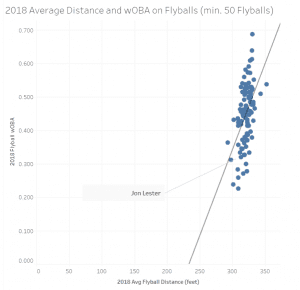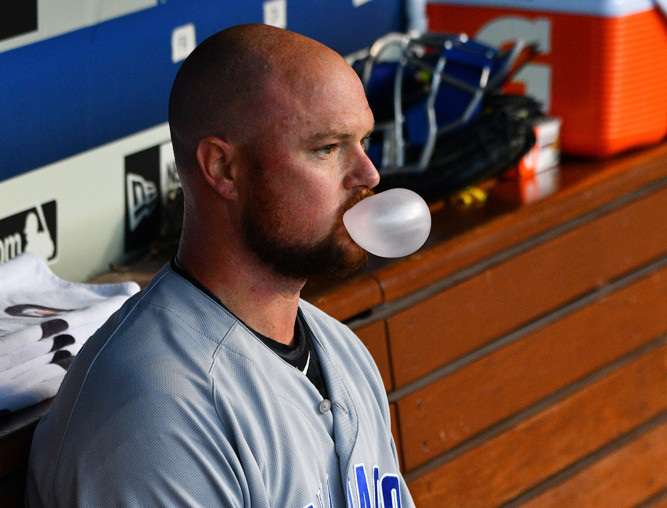On Sunday, the All-Star Game rosters were unveiled, and we engaged in our annual ritual of picking them apart and identifying the snubbed and the unworthy. Jon Lester was chosen for the NL roster, marking the fifth time he has been selected for the Midsummer Classic. On the surface, his 11-2 record, 2.45 ERA and 1.17 WHIP are befitting of an All-Star pitcher.
We can debate about whether pitchers should make an All-Star roster on the basis of measures like wins, ERA and WHIP without regard for their peripheral stats, but in Fantasy, digging deeper into the stats is one way we get our competitive edge. When we look just beneath the surface of Lester’s 20-win pace and pristine ERA, we find some cause for concern. During his best years with the Red Sox, Lester was a reliable inducer of grounders, but his 39.0 percent ground ball rate is his lowest since 2007. His control is no worse than usual, but a subpar 27.0 percent swing rate on pitches outside of the strike zone has left him with his highest walk rate (8.7 percent) in seven years.
A propensity for flyballs and walks can be forgiven by Fantasy owners if a pitcher misses bats. Among the selected All-Star starting pitchers, Lester stands out — but not in a good way — with an 18.6 percent strikeout rate that is nearly four percentage points below the Major League average. He and Miles Mikolas are the only All-Star starting pitchers with K-rates under 25 percent, and Mikolas has the benefit of a minuscule walk rate (3.9 percent) and a 50.1 percent ground ball rate.
All-Star for Sale?
In some important ways, Lester hasn’t kept pace with his All-Star peers over the first half of this season, so does that mean his fantasy owners should trade him before the shine comes off his surface stats? Maybe a better question is: who’s buying?
If the results of a Twitter poll are any indication, the answer is “not many owners.” I asked my Twitter followers whether they currently view Lester as a pitcher to buy, hold or sell, and only five percent responded with “buy.” On the other hand, 57 percent would be looking to sell. It seems they will have a hard time finding takers unless they offer him at a bargain price.
Poll: Right now, do you view Jon Lester as a buy, hold or sell in fantasy?
— Al Melchior (@almelchiorBB) July 9, 2018
If only Lester possessed some hidden skill — something that indicated he could actually maintain a standard of performance close to his year-to-date levels — maybe owners could take advantage of a potential bargain. It turns out this may actually be the case.
Of the 75 pitchers who have allowed at least 50 flyballs in both 2017 and 2018, only eight have limited the average distance of flyballs they allowed to no more than 315 feet in both seasons. (For a basis of comparison, the median average flyball distance for pitchers with at least 50 flyballs in either 2017 or 2018 is 321 feet.) With average flyball distances of 310 feet in 2017 and 313 feet in 2018, Lester is one of the eight.
Only three pitchers have stayed under the 315-foot threshold for three years running. Lester is not one of them, but if you shaved one foot off his 2016 average of 316 feet, he would join Blake Snell, James Paxton and Eduardo Rodriguez as one of the most consistent dampeners of flyballs over the last three seasons.
Keep up with all the latest Fantasy Baseball happenings with Van Lee, Jeff Zimmerman and Rob Silver on the Launch Angle Podcast.
Despite his meager ground ball rate, Lester — like Paxton and Snell — has a HR/9 ratio (1.02) below the Major League average of 1.15. (Rodriguez, who has the burden of pitching in the AL East, merely matches that mark.) Not only can Lester’s Fantasy owners hope he can continue to prevent home runs at an above-average rate, but he should be able to limit production on flyballs in general. So far this season, there has been a strong correlation (R-squared = 0.25, p < .0001) between average flyball distance and wOBA on flyballs. As the graph below shows, only eight of the 102 pitchers who have allowed at least 50 flyballs in 2018 have yielded a lower wOBA on flyballs than Lester’s .320.

Can Lester Defy the FIP?
If Lester can continue to avoid long flies, and in turn, limit the damage done by flyballs, he can outperform his 4.57 xFIP and 4.28 FIP by a wide margin going forward. While some regression from his .247 BABIP and 84 percent strand rate is almost certain, and Lester is due to see his ERA and WHIP rise, it should not be to the degree where he couldn’t be useful in any mixed league with at least 12 teams.
Also, it’s not just Lester who has been benefiting from short flyballs. Entering Monday’s start against the Reds, Mike Clevinger was matching his 3.11 ERA from last season, even though his strikeout rate had fallen from 27.3 to 22.2 percent, and a .334 wOBA on flyballs was partly why. Despite a modest 18.9 strikeout rate and a tough home park, Jhoulys Chacin has held opponents to a 317-foot average distance and .271 wOBA on flies. Zach Eflin has been getting attention for his increased velocity and K-rate, but his average flyball distance of 308 feet is just as impressive. Incredibly, he has allowed two home runs in 31.1 innings at Citizens Bank Park this year.
Lester may not have a strikeout rate like Eflin’s or even Clevinger’s, but he has a much longer track record of limiting the distances of flyballs hit off him. That might not be enough to put him on a par with his fellow All-Star starting pitchers, but it could make him a Fantasy All-Star if you can get him at a modest price.
Statistical credits: 2018 stats are current for games played through Sunday, July 8. Flyball distance and wOBA data are from Baseball Savant. All other data are from FanGraphs.
Obviously, you are a Fantasy Baseball diehard. Why not relive draft day all over again? Head on over to Fantrax where you can draft a team 364 days a year.

